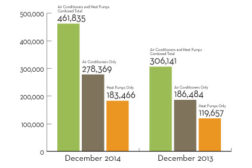Air-Source Heat Pumps
2015 New Residential Product Roundup for HVACR Contractors
Read More
April 13, 2015: Central Air Conditioner and Heat Pump Shipments Up Nearly 20 Percent in February
Year-to-Date Combined Shipments of Central Air Conditioners and Air-Source Heat Pumps Up 24.5 Percent
April 13, 2015
Contractors Key in Reclamation’s Future
Financial Benefits, Reclaimer Assistance, Secure Supply Keep the Process Attractive
Read More
Reclaimers Find Opportunity in HCFC Phaseout
Demand for Recovery Products, Services Likely to Grow
Read More
Refrigerant Recovery: Technology and Tips
The Right Tools and Advice from Experts Make This Essential Process Easy
Read More
March 16, 2015: Central Air Conditioner, Heat Pump Shipments Jump Nearly 30 Percent in January
US Shipments of Central Air Conditioners Increased 34.1 Percent
March 16, 2015
Heat Pumps Continue Northern Migration
New Products Feature Higher Efficiencies, Strong Performance Extreme Temps
Read More
HVAC Portable Units Increase their Utility
Units that Both Cool and Heat Are in High Demand
Read More
Copyright ©2024. All Rights Reserved BNP Media.
Design, CMS, Hosting & Web Development :: ePublishing









